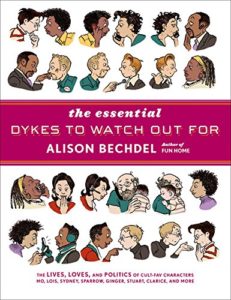Synopsis
Alison Bechdel’s comic strip Dykes To Watch Out For became a countercultural institution among lesbians and discerning non-lesbians all over the planet. Bechdel self-syndicated Dykes to Watch Out For for twenty-five years, from 1983 to 2008. The award-winning generational chronicle has been called “one of the pre-eminent oeuvres in the comics genre, period.”
From: Dykes to Watch Out For
Notes on This Title
Originally serialized in gay and lesbian newspapers, including Funny Times, as well as online on the author’s website, the first print collections of these strips were spread across 11 volumes, starting in 1986 and concluding in 2005.
Essential Dykes to Watch Out For, printed in 2008, collects many of the previously published strips.
Awards
2009 Ferro-Grumley Award for LGBT Fiction
Reviews
Starred review: “The greatest lesbian soap opera—527 episodes and, though suspended at the moment, counting—is Bechdel’s miraculously well-sustained chronicling of a circle of friends over the course of 20 years, Dykes to Watch Out For. Like its only possible peer among current comic strips, Lynn Johnston’s For Better or Worse, and its great forebear, Frank King’s GasolineAlley, Dykes plays out in real time. Characters age, change, see their parents die, and have children. Basically, everything revolves around erstwhile radical lesbian Mo, whose worries for the future persist as she and her friends realize their dreams. Life does get better for gay people, though struggles continue, as the determined-to-be-transgender preteen son of a newer cast member and the dissolution of two long-lived lesbian marriages remind them and us. Mo’s kvetching centrality is complemented by the chorus of skewed radio and TV commentary and headlines that strikingly often intones a satirical leitmotiv under the characters’ conversation, which is always pitch-perfect for the highly intelligent, well-educated, earnestly committed, and witty bunch they are. Bechdel’s comics autobiography Fun Home (2006) has brought her much greater general attention than Dykes ever did, but make no mistake—the strip is her masterpiece.” (Source: Booklist, vol 105, number 5, p32)
Starred review: “This ongoing comic strip chronicles the lives of a tight-knit group of lesbian friends over an astounding 21 years of life, work, love, boredom, political activism and countless reversals of fortune. At its heart are six women: the promiscuous Lois, a feminist bookstore clerk with a penchant for gender-bending; her two roommates, the overworked academic Ginger and self-identified ‘bisexual lesbian’ Sparrow; their domestically partnered friends Clarice and Toni; and Mo, who despite (or perhaps because of) her frequent politically charged outbursts of neurosis is the hub of her circle. These characters, flawed but endearing, are brought to life by Bechdel’s quirky artistic sensibility. Facial expressions are carefully nuanced, and she seems to take great joy in using small details to differentiate emotions. Late in the collection, when a character receives treatment for cancer, a tiny caret in her cheek is enough to transform her from a fresh-faced mischief-maker into a sallow and frightened chemo patient. What cannot be overemphasized is the sheer scope of the collection, which follows these women from idealistic young adulthood to contentedly disillusioned middle age and, for some, parenthood. All eventually end up a little more haggard than they began, but there isn’t one whose Bechdel-illustrated bags under her eyes were not hard fought for and hard won.” (Source: Publishers Weekly)
“Taken together, these comic strips don’t have the tightly coiled impact of ‘Fun Home,’ but in some ways they offer greater consolations — they’re looser, more funny, and they offer the chance to watch a group of very appealing women grow and change (and struggle to have better sex) over the course of more than two decades. Ms. Bechdel calls her strips ‘half op-ed column and half endlessly serialized Victorian novel,’ and that’s not far off. I suspect that, over the years, ‘Dykes to Watch Out For’ has been as important to new generations of lesbians as landmark novels like Rita Mae Brown’s ‘Rubyfruit Jungle’ (1973) and Lisa Alther’s ‘Kinflicks’ (1976) were to an earlier one.” (Source: The New York Times)
“It started as a collection of humorous one-offs about lesbian life, but DTWOF quickly resolved into a running saga about a circle of friends in a small college town. There’s neurotic Mo; Lois, the impulsive, trend-following sensualist; Clarice and Toni, the longtime couple who eventually have a child; Ginger, the rational yet terminally ambivalent professor; Sparrow, a new-age optimist; and Jezanna, the alpha-female owner of the local feminist hub, Madwimmin Books.
“Thinking about DTWOF, it’s easy to focus on the content. Character and theme are so central, some might put the strip in a class with its artistically unambitious forebear, Doonesbury. People always mention its politics, particularly its treatment of different races and genders. But look deeper, and you can see the depth, complexity and ambition of Bechdel’s graphical achievement. Her unique line is curvaceous and fleshy, with much more physical impact than most comic creators’. The linework of the mid-’90s strips often tops that of Fun Home. With the latter, Bechdel was clearly pouring out scenes she had firmly established in her mind. In DTWOF, her line is more exploratory — she’s following wherever her nib leads her.” (Source: NPR)
Interviews
The Comics Journal: “The Alison Bechdel Interview”
Little Village: “Interview: Alison Bechdel on queerness, fame and therapy“
